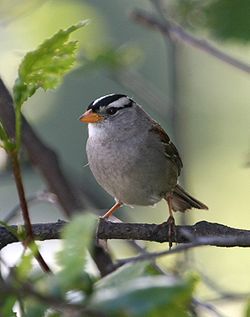Species
The species in the genus Zonotrichia are:
| Image | Scientific name | Common name | Distribution |
|---|
 | Zonotrichia leucophrys | White-crowned sparrow | North America |
 | Zonotrichia albicollis | White-throated sparrow | Canada and New England |
 | Zonotrichia atricapilla | Golden-crowned sparrow | north-central Alaska (including the Aleutian Islands as far west as Unimak Island) and central Yukon south to the northwestern corner of the US state of Washington, and wintering from southern coastal Alaska to northern Baja California |
 | Zonotrichia capensis | Rufous-collared sparrow | south-east of Mexico to Tierra del Fuego, and on the island of Hispaniola |
 | Zonotrichia querula | Harris's sparrow | north part of central Canada (primarily the Northwest Territories and Nunavut, ranging slightly into northern Manitoba and Saskatchewan) |
| † Zonotrichia robusta | | Miramar Formation, Argentina (Pleistocene) [3] |
These birds have brown backs streaked with black, and distinctive head markings. Their cup nests, built by the female, are of plant material lined with fine grasses and constructed on the ground, low in a tree or bush, or in a niche in a wall.
The female lays brown-blotched greenish-blue or greenish white eggs, which she incubates for 12–14 days. The male helps in feeding the chicks.
Zonotrichia sparrows feed on the ground on seeds, fallen grain, insects and spiders.
This page is based on this
Wikipedia article Text is available under the
CC BY-SA 4.0 license; additional terms may apply.
Images, videos and audio are available under their respective licenses.





